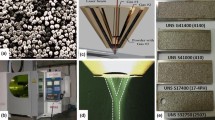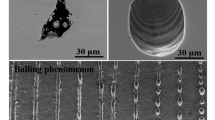Abstract
During liquid metal embrittlement a liquid metal infiltrates grain boundaries of a compatible solid metal, interrupting the inter-grain bonds and weakening the metal. Ongoing research has proposed that this effect may be used to perform additive/subtractive hybrid machining to fabricate replacement components, using relatively simple equipment and low material and instrument costs. The gallium/aluminum pairing is of particular interest due to the usage of aluminum in a wide variety of structural and aerospace applications coupled with gallium’s nontoxicity and melting point just above room temperature, which facilitates storage and transport. To activate aluminum to gallium infiltration, the surface oxide formed on aluminum in atmosphere must first be removed simultaneously with a significant amount of bulk metal to promote flow control of the liquid metal. Three targeted techniques for oxide removal were tested and compared, specifically mechanical abrasion, chemical etching, and laser ablation. Mechanical abrasion is simple to implement but lower precision. Chemical etching requires significant prep work and cleanup but could operate on entire sheets of substrate simultaneously with proper masking. Although laser ablation requires the most complex instrumentation, it requires minimal prep work and provides the greatest precision, making it ideal for the manufacturing application under development here.

















Similar content being viewed by others
Data Availability
The mechanical abrasion, chemical etching, and laser ablation data which support the findings of this study are available from the corresponding author upon reasonable request.
References
H.S. Nam and D.J. Srolovitz, Molecular Dynamics Simulation of Ga Penetration Along Sigma 5 Symmetric Tilt Grain Boundaries in an Al Bicrystal, Phys. Rev. B, 2007 https://doi.org/10.1103/PhysRevB.76.184114
H.S. Nam and D.J. Srolovitz, Molecular Dynamics Simulation of ga Penetration Along Grain Boundaries in Al: A Dislocation Climb Mechanism, Phys. Rev. Lett., 2007 https://doi.org/10.1103/PhysRevLett.99.025501
D.M. Saylor et al., Distribution of Grain Boundaries in Aluminum as a Function of Five Macroscopic Parameters, Acta Mater., 2004, 52(12), p 3649–3655.
C.C. Chang and J.Y. Uan, Ductile-to-brittle Transition for the Aluminum Alloy Contacting to Liquid Gallium Metal, J. Alloy. Compd., 2008, 464(1–2), p 146–149.
A. Itoh, J. Izumi, K. Ina, and H. Koizumi, Brittle-to-ductile Transition in Polycrystalline Aluminum Containing Gallium in the Grain Boundaries, J. Phys. Conf. Ser., 2010, 240, p 012033. https://doi.org/10.1088/1742-6596/240/1/012033
M. Rajagopalan et al., Atomic-scale Analysis of Liquid-gallium Embrittlement of Aluminum Grain Boundaries, Acta Mater., 2014, 73, p 312–325.
H. Prestonthomas, The International Temperature Scale of 1990 (Its-90), Metrologia, 1990, 27(1), p 3–10.
J.E. Hatch, Aluminum: Properties and Physical Metallurgy, American Society for Metals, Metals Park, Ohio, 1984.
Y. Kodama et al., Acoustic-Emission Associated with the Fracture of Al and Al-Alloy Embrittled by Liquid Gallium, Mater. Sci. Eng. Struct. Mater. Prop. Microstruct. Process., 1994, 176(1–2), p 231–235.
Z.R. Obidov et al., Corrosion of Al+2.18% Fe Alloy Doped with Gallium, Prot. Metals Phys. Chem. Surf., 2011, 47(5), p 654–657.
J.Y. Uan and C.C. Chang, Characterization of Gallium-induced Intergranular Fracture Surface and the Auger Electron Spectroscopic Analysis for mg Grain Boundary Segregation in AA6061 T4 Al-Mg-Si Alloy, Mater. Trans., 2004, 45(6), p 1925–1932.
S.P. Yatsenko, N.A. Sabirzyanov, and A.S. Yatsenko, Dissolution Rates and Solubility of Some Metals in Liquid Gallium and Aluminum, Int. Conf. Liquid Amorph. Metals, 2008, 98, p U654–U660.
G. Choi, et al., Mechanism of Hydrogen Generation via Water Reaction with Aluminum Alloys Generating hydrogen on demand. 2010 18th Biennial University/Government/Industry Micro-Nano Symposium, 2010.
J.M. Woodall, J. Ziebarth, and C.R. Allen, The Science and Technology of Al-Ga Alloys as a Material for Energy Storage, Transport and Splitting Water, Procee. Energy Nanotechnol. Int. Conf., 2007, 2007, p 15–17.
M. Woodall, et al., Generating Hydrogen on Demand by Splitting Water with Al Rich Alloys. Clean Technology 2008: Bio Energy, Renewables, Green Building, Smart Grid, Storage, and Water, 2008: pp. 313-315.
J.M. Woodall et al., Recent Results on Splitting Water with Aluminum Alloys, Mater. Innov. Emerg. Hydrog. Econ., 2009, 202, p 121–127.
J.T. Ziebarth et al., Liquid Phase-enabled Reaction of Al-Ga and Al-Ga-In-Sn Alloys with Water, Int. J. Hydrog. Energy, 2011, 36(9), p 5271–5279.
L.F.M.M.F. Santos, F.C. Abrego, K.F.A. Torres, and D.S. Raimundo, Inducing Aluminum Oxide Growth at Room Temperature and Atmospheric Pressure Through Low Dose Gamma-Ray Irradiation, Radiat. Phys. Chem., 2023, 204, p 110666. https://doi.org/10.1016/j.radphyschem.2022.110666
M.E. Trybula, A. Zydek, P.A. Korzhavyi, and J. Wojewoda-Budka, Structure and Behavior of Oxide-Coated Aluminum in Contact with Acidic and Alkaline Aqueous Solutions–A Reactive Molecular Dynamics Simulation Study, J. Phys. Chem. C, 2023, 127(5), p 2493–2507. https://doi.org/10.1021/acs.jpcc.2c06617
D.H. Xuan, Y.P. Qiu, and P. Wang, Rapid Hydrogen Generation from the Reaction of Aluminum/Activated Charcoal Composite with Alkaline Solution, J. Alloys Compd., 2023, 947, p 169611. https://doi.org/10.1016/j.jallcom.2023.169611
W.Y. Zhang et al., Broadening the pH Range of Molecular Oxygen Activation for Zero-valent Aluminum by Ball-milling Surface Modification, Appl. Surf. Sci., 2023, 622, p 156881.
Y.X. Huang et al., Fluxless Soldering with Surface Abrasion for Joining Metal Foams, Mater. Sci. Eng. a-Struct. Mater. Propert. Microstruct. Process., 2012, 552, p 283–287.
M.A. Islam and Z. Farhat, Wear of A380M Aluminum Alloy Under Reciprocating Load, J. Mater. Eng. Perform., 2010, 19(8), p 1208–1213.
D. Kumar, H. Roy, and B.K. Show, Tribological Behavior of an Aluminum Matrix Composite with Al4SiC4 Reinforcement under Dry Sliding Condition, Tribol. Trans., 2015, 58(3), p 518–526.
P. Kwolek et al., Tribological Properties of the Oxide Coatings Produced onto 6061–T6 Aluminum Alloy in the Hard Anodizing Process, J. Mater. Eng. Perform., 2018, 27(7), p 3268–3275.
Y. Huang, D.K. Sarkar, and X.G. Chen, Superhydrophobic Aluminum Alloy Surfaces Prepared by Chemical Etching Process and their Corrosion Resistance Properties, Appl. Surf. Sci., 2015, 356, p 1012–1024.
J.H. Jeong et al., Electrochemical AC etching of aluminum foils in hydrochloric acid electrolytes, Aluminium Alloys: Their Physical and Mechanical Properties, Pts 1–3. J.H. Driver et al., Ed., Transtec Publications Ltd, Zurich-Uetikon, 1996, p 1565–1570
J.W. Kang, Y.H. Shin, and Y.S. Tak, Growth of Etch Pits Formed during Sonoelectrochemical Etching of Aluminum, Electrochim. Acta, 2005, 51(5), p 1012–1016.
C.C. Lin and C.C. Chang, Effect of Conditions of Ultrasonic and Electrochemical Etching on Morphology and Capacitance of Etched Aluminum Electrodes, Electrochemistry, 2011, 79(7), p 553–557.
M. Lightstone, et al. Time-resolved spectroscopic measurements of aluminum oxidation in a laser ablation event. in Conference of the American-Physical-Society-Topical-Group on Shock Compression of Condensed Matter. 2007. Waikoloa, HI: Amer Inst Physics.
N. Morshedian, Specifications of Nanosecond Laser Ablation with Solid Targets, Aluminum, Silicon Rubber, and Polymethylmethacrylate (PMMA), Plasma Sci. Technol., 2017, 19(9), p 8.
M.E. Shaheen, J.E. Gagnon, and B.J. Fryer, Excimer Laser Ablation of Aluminum: Influence of Spot Size on Ablation Rate, Laser Phys., 2016, 26(11), p 8.
J.H. Yin et al., Nd: YAG Laser Ablation of Aluminum Alloy 6061 Before and After Silicon Dioxide Coating, J. Alloy. Compd., 2021, 877, p 12.
A.H. Faraji et al., Numerical Modeling of Fluid Flow, Heat, and Mass Transfer for Similar and Dissimilar Laser Welding of Ti-6Al-4V and Inconel 718, Int. J. Adv. Manuf. Technol., 2021, 114(3–4), p 899–914.
CRC Handbook of Chemistry and Physics. 81st ed, ed. D.R. Lide. 2000, Boca Raton, FL: CRC Press.
Acknowledgments
This investigation was conducted for the US Army Corp of Engineers, ERDC, Installations and Operational Environment RDA, under Program Element Number 601102A, Project AB2, Task 03/04. The technical monitor was Dr. Elisabeth Ferguson.
Author information
Authors and Affiliations
Corresponding author
Ethics declarations
Conflict of interest
The authors declare no competing financial or ethical interest which could influence the work discussed in this manuscript.
Ethical Approval
Not applicable.
Additional information
Publisher's Note
Springer Nature remains neutral with regard to jurisdictional claims in published maps and institutional affiliations.
Rights and permissions
About this article
Cite this article
Christensen, J.M., Cody Goss, R. & Masters, B.C. Surface Oxide Removal in Preparation for Controlled Liquid Metal Embrittlement. J. of Materi Eng and Perform (2023). https://doi.org/10.1007/s11665-023-08979-y
Received:
Revised:
Accepted:
Published:
DOI: https://doi.org/10.1007/s11665-023-08979-y




